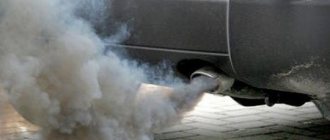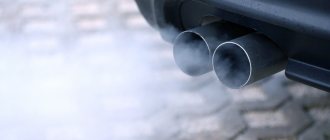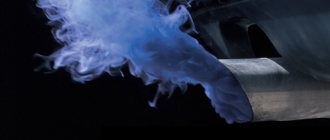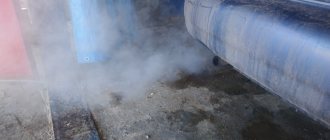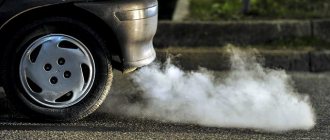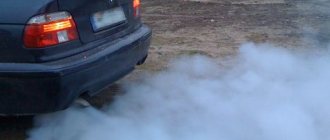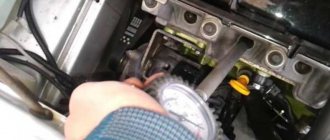Typically, when all vehicle systems are in good condition, exhaust gases from a warm engine are colorless. Therefore, the appearance of black smoke from the exhaust pipe may alert an attentive motorist. However, trouble does not come alone and often, along with the appearance of smoke, starting the engine becomes difficult, fuel consumption increases, the engine begins to work intermittently and traction is lost. Such symptoms will not leave even the most inattentive and lazy driver indifferent.
The appearance of black smoke indicates two signs:
1. Re-enrichment of the air-fuel mixture.
As you know, the ideal combination for an engine is a gasoline to air ratio of 1:14.7.
When less air comes in or gasoline overflows, the mixture becomes “Rich.” 2. Insufficient fuel combustion.
If the mixture does not burn in the combustion chamber or burns but not completely, it enters the exhaust system and there it partially burns out due to the high temperature. From this inadequate combustion of the mixture, black soot appears, which is released into the atmosphere.
Reasons for the appearance of black smoke from the muffler on a gasoline engine
On cars with a gasoline engine, the cause of over-richness of the mixture may be interruptions in the fuel system, ignition system and electronics failures. The following items need to be checked:
Fuel. The appearance of black smoke after refueling a car may indicate low-quality fuel. The only thing that will help here is draining the fuel, or completely consuming it and refueling at another gas station.
Oxygen sensor (Lambda probe)
. This sensor is installed on the exhaust manifold and is necessary to assess the amount of oxygen that remains after combustion and, based on this data, the computer adjusts the fuel supply to the cylinders. When it fails, no signal is received from it and the ratio of oxygen to gasoline is not regulated in any way, as a result of which the mixture becomes enriched.
Injectors.
Serviceable injectors on injection engines supply fuel by injecting it under high pressure. Over time, the injectors become clogged and, instead of injecting, they begin to pour fuel, causing the mixture to become heterogeneous and burn poorly. Also, the injectors can “hang” in the open position and constantly supply gasoline to the combustion chamber, regardless of the cycle occurring in the cylinder.
Sensors
A failed sensor can send incorrect signals to the computer, which can cause the injection timing and fuel volume to be incorrect. When checking sensors on AvtoVAZ cars, the pinout of the BOSCH M7.9.7 and January 7.2 ECU may be useful
Thermal clearances of valves.
If the valve clearances are increased, the intake valve is not held open long enough, causing little air to enter the cylinder.
Air filter.
Over time, the air filter becomes clogged, the flow of air to the intake system is limited and not enough air enters the cylinders and the mixture becomes “rich”.
Incomplete combustion of the air-fuel mixture occurs when the necessary conditions for this are not created in the combustion chamber. This may happen for the following reasons:
Spark plug.
Spent spark plugs simply do not ignite the mixture and it goes out into the outlet without burning. And it burns out in the exhaust system.
Compression. When there is no compression in the cylinder, the compression stroke does not occur properly, the mixture burns unevenly, and the residue exits through the exhaust valve.
Injector
Let's move on to the injection power system, an example would be the VAZ-2109. There is no carburetor here, however, increased fuel supply can be provided by a malfunction of the injectors.
Fuel system sensors can also malfunction.
The remaining reasons for the appearance of black smoke from the chimney are identical to the VAZ-2106.
For all types of engines, the cause may be a breakdown of the cylinder head gasket.
But black smoke is the result of a breakdown in which a gap has appeared between the cylinder and the oil supply channel to the cylinder head, so such a malfunction will be accompanied by oil consumption.
Black smoke on carburetor engine
I would especially like to mention carburetor engines. On such engines, the cause of black smoke will most likely be the carburetor itself.
The quality of the air-fuel mixture may be incorrectly adjusted. To adjust it, there is a “mixture quality screw” on the carburetor. It changes the amount of air that will enter the combustion chamber.
Due to low-quality fuel and the ingress of fine dirt, the needle valve, which is the most important part in the carburetor, can “stick”. It begins to leak fuel, as a result of which fuel consumption increases and black smoke appears.
The carburetor also has a jet designed to meter fuel. When it becomes clogged or coked, the accuracy of the dosage is lost and the mixture becomes over-enriched again.
In this case, a complete disassembly and thorough cleaning of all carburetor elements can help. Or replacing the needle valve and jet. But you should not disassemble the carburetor yourself if you have no experience in car repairs.
Good old carburetor
What does dark exhaust coming from a car mean? With carburetor engines everything is simple and clear. Most owners of cars with such an engine encountered one problem when it flooded, and it began not only to sneeze, but also to trip. All this was accompanied by clouds of smoke from a black muffler.
Responsibility usually lies with one of the following:
- carburetor needle valve;
- ignition;
- piston rings, valves.
Sometimes the needle valve begins to stick or allows a lot of fuel to pass through, which actually leads to a richer mixture. The result is its incomplete combustion. And if you pour low-quality gasoline into the tank, this threatens to clog the jets.
Another reason lies in the spark plugs or incorrect ignition timing. The result is identical - the fuel does not burn completely, and black smoke begins to pour out of the chimney.
Finally, the problem is caused by worn piston rings, as well as worn out valves. But in order to eliminate it, you shouldn’t act on your own, relying on your own strength - you need the help of qualified craftsmen.
Black smoke on diesel engines
For cold diesel engines, black smoke from the exhaust pipe is normal. The fact is that in them the combustion of the mixture is carried out by compressing air and forced injection of fuel into it. When the combustion chamber is cold, the air-fuel mixture does not burn completely, but as the engine warms up, everything returns to normal and the smoke disappears.
The appearance of black smoke when driving under load is also considered normal, so there is no need to panic.
Here, as with a gasoline engine, smoke appears due to low-quality fuel, its overflow or incomplete combustion, and the problems are basically similar, but there are some nuances.
Air filter.
There are no nuances here, everything is the same as on a gasoline engine: the filter becomes clogged, air does not flow, the mixture becomes rich.
Valve clearances.
Everything is the same here: the valves open briefly, little air flows in, but there is a lot of fuel. Ignition marks. Incorrectly set ignition affects the timing of fuel supply to the cylinders. As you know, this is very important for diesel engines. Therefore, setting the ignition according to the marks must be approached responsibly.
Compression.
As mentioned above, the air-fuel mixture in diesel engines burns due to compression. Insufficient compression in the cylinder will not allow the air to be compressed properly and detonation will not occur when fuel is injected, and then everything follows a familiar scenario: unburned fuel enters the exhaust manifold, where it accumulates and burns out due to the high temperature.
Fuel injection pump (high pressure fuel pump).
The injection pump is precisely designed to supply fuel at the required moment and in the required quantity. It may need adjustment or repair. In this case, it is better to contact specialists.
Particulate filter. Environmental regulations introduced in Europe have forced diesel car manufacturers to install a particulate filter. It is installed on the exhaust pipe and does not live forever. Sooner or later it gets clogged and fails. True, there will be little smoke in the event of such a breakdown.
Making a diagnosis based on exhaust colors
Diesel engines, as well as gasoline engines, can have exhausts of various colors. More often it is white, bluish, gray and black smoke.
Let's start with white. Often white is the name given to smoke with a bluish tint. This happens when the turbine is destroyed and the lubricant gets directly into the intake tract. In such a situation, bluish smoke pours out of the chimney. But an inexperienced car enthusiast will easily mistake it for white smoke. And if you smell it, then it’s immediately clear and understandable what the reason for its appearance is.
Many people have burned vegetable oil or butter in a frying pan at least once in the kitchen. The smell is about the same. This smoke can also be confused with steam, which is more often observed in the winter months from the exhaust of not only diesel cars. It's all because of the water that appears as a result of combustion.
Later, after the engine has warmed up, the steam will not be noticeable, although it will not go away. This can be easily checked. You just need to place your palms near the exhaust. The palm will be slightly damp. This steam causes significant inconvenience when tuning the engine, especially in winter. For high-quality settings, you have to warm up the unit for a long time. And in cold weather the adjustment may not be possible at all.
Consequences of black smoke
At first glance, it may seem that nothing bad will come of this. However, this is just the beginning. If the problem starts, the following may happen:
Exhaust pipe burnout.
This is the smallest thing that can happen. The fuel will burn on the walls of the pipe and thereby slowly destroy it, this will happen especially quickly on old cars. Welding or replacing the pipe will help here.
Failure of the catalyst. A catalytic converter is needed to retain harmful substances and produce less harmful gases at the output. If it gets clogged, the engine first loses power, and then cannot raise the speed at all above two or three thousand.
Lambda probe. The oxygen sensor located before the catalytic converter is also exposed to even higher temperatures due to fuel combustion and this will not have a very good effect on its service life. The cost of such a sensor is not small.
Water hammer. Although the fuel exits into the exhaust manifold, some still remains in the combustion chamber and this can lead to water hammer. This is especially scary for diesel engines, because the pressure there is much higher than that of gasoline engines.
Troubleshooting
Diesel.
The operating features of diesel fuel equipment do not allow us to fully independently identify the cause of black smoke. All that can be done is to check and replace the fuel and air filters, and also measure the compression.
If this does not help and the compression indicators are normal, then all that remains is to contact a good fuel equipment specialist so that he can check on a bench the functionality of the fuel pump and injectors.
For carburetor cars, everything is much simpler.
No stands required. Identifying the cause should begin with the air filter and spark plugs.
The filter needs to be replaced, and it is advisable to visually evaluate the spark plugs - a large gap between the contacts can become an additional factor in the appearance of black smoke.
After assessing the condition of the spark plugs, it is worth checking the ignition system both for the presence of contacts of all connections and for correct installation.
Then the valve clearances are checked, and then the carburetor itself.
Don't forget that engine wear can also cause black smoke, so measuring compression in the cylinders won't hurt either.
Injector.
As for the VAZ-2109 injector, you can independently check only the ignition system and compression in the cylinders.
Since in this case the automatic timing adjustment is performed using washers, it will be impossible to check the valve clearance in the garage and set the correct clearance.
Regarding the injector, the problem associated with the sensors can only be identified using a special scanner and eliminated by replacing damaged sensors, and malfunctioning of the injectors can be done on a special stand, followed by washing and adjusting them.
